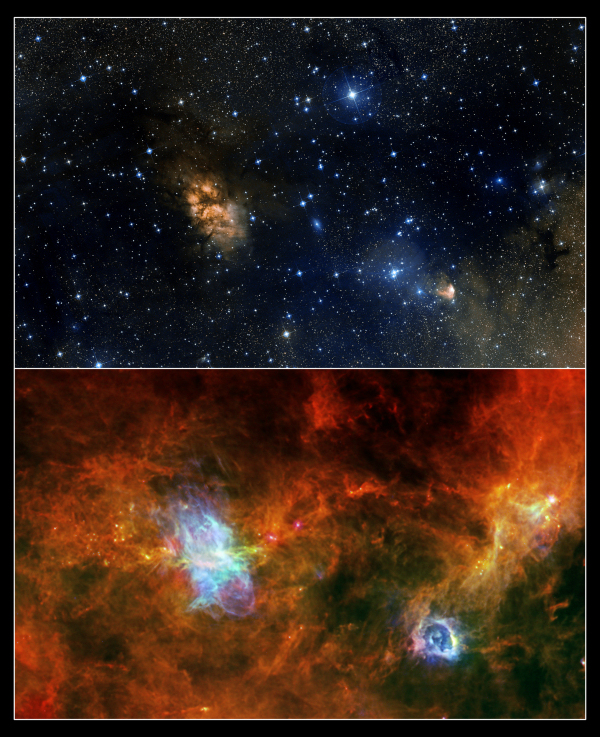Tangled nests and filaments: stellar nurseries in Vela-C
The Vela Molecular Ridge is a vast star-forming complex in the plane of our Galaxy, the Milky Way. Observing this region at far-infrared wavelengths, ESA's Herschel Space Observatory has obtained an extraordinarily detailed image of the most massive component of this molecular complex, known as Vela-C.
Located roughly 2300 light years away, Vela-C saw the onset of star formation less than a million years ago – relatively recently on astronomical timescales. Massive, as well as low- and intermediate-mass, stars are being born in this region, making it an ideal laboratory to study the birth of different populations of stars.
This image reveals previously unseen detail in the cold mixture of gas and dust that pervades the region. Cosmic dust is a minor but crucial component of the interstellar medium and, due to its low temperature, it shines brightly at the far-infrared wavelengths that Herschel is designed to observe. By detecting emission from cosmic dust, astronomers can unravel the distribution of the raw material out of which stars form.
The coldest and densest portions of the cloud complex release most of their radiation at the longest wavelengths probed by Herschel, shown in red in this image. The cloud material is organised in a highly sub-structured network, with tangled and less organised material alternating with more defined and elongated filaments. Intricate bundles of material can be seen on the left, centre and right of the image. These nest-like structures are linked to one another by dense, ridge-like filaments.
A number of white flecks dot the clouds and, in particular, the prominent ridge-like filaments in Vela-C. These flecks are in fact pre-stellar cores – compact clumps of matter that might eventually give rise to star formation – and proto-stellar cores, whose density is high enough for star formation to have already begun, eventually resulting in fully-fledged stars. As a result of Herschel's unparalleled resolution and sensitivity at these wavelengths, astronomers are able to carry out detailed studies of the properties, such as their mass and temperature, of the different cores across the nests and filaments. From the Herschel image, it appears that the majority of pre- and proto-stellar cores with large masses are found along the two densest filaments, suggesting that these sites are the most likely, in the cloud, to host the formation of massive stars.
Studies done with Herschel data seem to indicate that the ridge-like filaments in star-forming regions such as Vela-C formed from converging flows of matter in the interstellar medium. The high densities in these thick, elongated structures induce massive clumps of matter to collapse under their own gravity, giving rise to high-mass stars. The nest-like structures, on the other hand, appear to be dominated by turbulence rather than by gravity and are likely to form mainly low- and intermediate-mass stars.
Not only does Vela-C host seeds of future stellar generations, it also comprises a handful of objects that have already evolved into young, massive stars. Embedded in the central part of the image is a stellar cluster whose stars are not visible in the Herschel image, but their effects are. The butterfly-shaped structure at the centre of the image, known as RCW 36 (or Gum 20), is a result of winds and radiation released by the hot stars in this cluster. RCW 36 is an HII region – a pocket of gas that is being energised and ionised by the action of nearby young, massive stars. Due to its higher temperature relative to the colder material in the cloud, RCW 36 shines brightly at the shortest wavelengths probed by Herschel, indicated in blue in this image. In the lower right corner of the image is another HII region called RCW 34 (or Gum 19); it is unclear whether RCW 34 and the hot stars that illuminate it are part of the Vela-C molecular cloud or whether they are located farther away.
| Fast Facts | |
| Depicted object: | Vela-C molecular cloud |
| Additional details: | Part of the Vela Molecular Ridge; includes HII regions RCW 36 (centre) and RCW 34 (right) |
| Constellation: | Vela (the Sail) |
| Distance: | 2300 light years |
| Image Orientation: | North is about 45 degrees clockwise of the vertical direction; East is about 45 degrees counterclockwise of the vertical direction. |
| Image | |
| Satellite: | Herschel |
| Instruments: | PACS; SPIRE |
| Wavelengths: | 70 um (PACS; blue); 160 um (PACS; green); 250 um (SPIRE; red) |
| Field of view: | 1 degree × 3 degrees |
| Observation dates: | 18 May 2010 |
| Release date: | 9 July 2012 |
| Credit: | ESA/PACS/SPIRE/Tracey Hill & Frédérique Motte, Laboratoire AIM Paris-Saclay, CEA/Irfu - CNRS/INSU - Univ. Paris Diderot, France |
| Acknowledgments: | HOBYS Key Programme |
| Related publications: | T. Hill et al., 2011, A&A, 533, A94; T. Giannini et al., 2012, A&A, 539, A156 |
Contacts
Göran Pilbratt
Herschel Project Scientist
Research and Scientific Support Department
Science and Robotic Exploration Directorate
ESA, The Netherlands
Email: gpilbratt rssd.esa.int
rssd.esa.int
Phone: +31-71-565-3621



